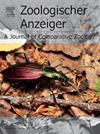鱼鳞的形态是否允许复杂的物种识别?伊朗刮藻鱼个案研究(Teleostei: Cyprinidae)
IF 1.5
3区 生物学
Q2 ZOOLOGY
引用次数: 0
摘要
本研究研究了18种伊朗刮藻属(Capoeta属和Paracapoeta属)的鳞片形态,以评估其变异模式,并评估系统发育关系是否与鳞片形态差异相关。系统发育分析利用了44条COI基因序列(651 bp)。形态评估包括宏观和微观特征,从尺度跨越五个身体区域和三个大小类。结果表明,这些属的鳞片类型一般为基础弹性摆线型和切分型。两属被试物种的鳞片在5个身体区域和不同体型类别之间的焦点形状、大小和位置有显著差异。尺度在三种类型中具有窄半径或宽半径:初级,次级和三级-存在于所有四个尺度域中的半径,即,导致尺度灵活性的四分割类型。鳞片的吻侧边缘光滑,凹陷,波浪状的圆形,齿状和扇形。此外,鳞片的形状和大小也各不相同,有的钝,有的尖,有的小,有的尖,有的短,有的长。这些尺度特征作为物种识别、分类和系统发育推断的可靠诊断工具。本文章由计算机程序翻译,如有差异,请以英文原文为准。
Does fish scale morphology allow the identification of species complex? A case study for algae scraper fishes in Iran (Teleostei: Cyprinidae)
This study investigated scale morphology in 18 Iranian algae-scraper species from the genera Capoeta and Paracapoeta to assess variation patterns and evaluate whether phylogenetic relationships correlate with scale morphological differences. Phylogenetic analysis utilized 44 COI gene sequences (651 bp) from the same specimens used for scale examination. Morphological assessment includes macro- and microscopic features from scales across five body regions and three size classes. The results revealed that the general scale type in these genera is a basal elasmoid cycloid and a sectioned type. The scales of examined species from two genera demonstrate remarkable variation in focus shape, size, and position among the five body regions and different size classes. The scales possess narrow or wide radii in three types: primary, secondary, and tertiary—the radii present in all four scale fields i.e., a tetra-sectioned type resulting in scale flexibility. The rostral margin of the scales was smooth, indented, and waved domical, dentate, and scalloped types. Additionally, the shape and size of the lepidonts varied, with some being blunt, pointed, tiny, sharp, short, and long. These scale characteristics serve as reliable diagnostic tools for species identification, classification, and phylogenetic inference within this species complex.
求助全文
通过发布文献求助,成功后即可免费获取论文全文。
去求助
来源期刊

Zoologischer Anzeiger
生物-动物学
CiteScore
2.80
自引率
7.10%
发文量
75
审稿时长
>12 weeks
期刊介绍:
Zoologischer Anzeiger - A Journal of Comparative Zoology is devoted to comparative zoology with a special emphasis on morphology, systematics, biogeography, and evolutionary biology targeting all metazoans, both modern and extinct. We also consider taxonomic submissions addressing a broader systematic and/or evolutionary context. The overall aim of the journal is to contribute to our understanding of the organismic world from an evolutionary perspective.
The journal Zoologischer Anzeiger invites suggestions for special issues. Interested parties may contact one of the editors.
 求助内容:
求助内容: 应助结果提醒方式:
应助结果提醒方式:


